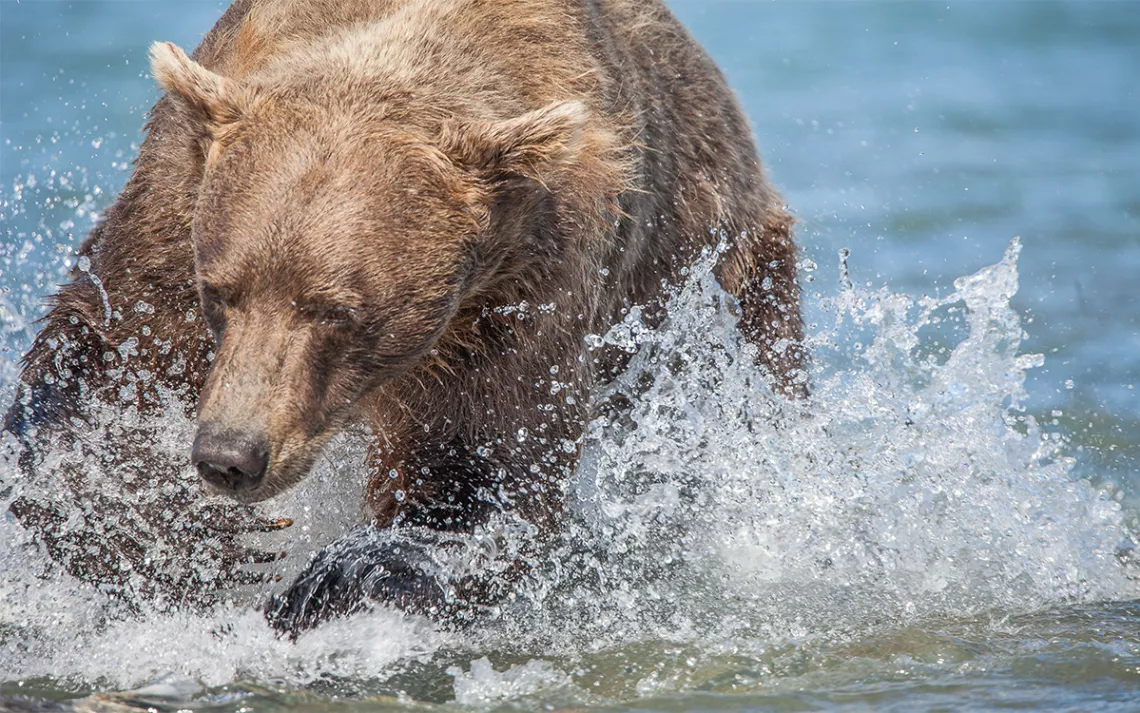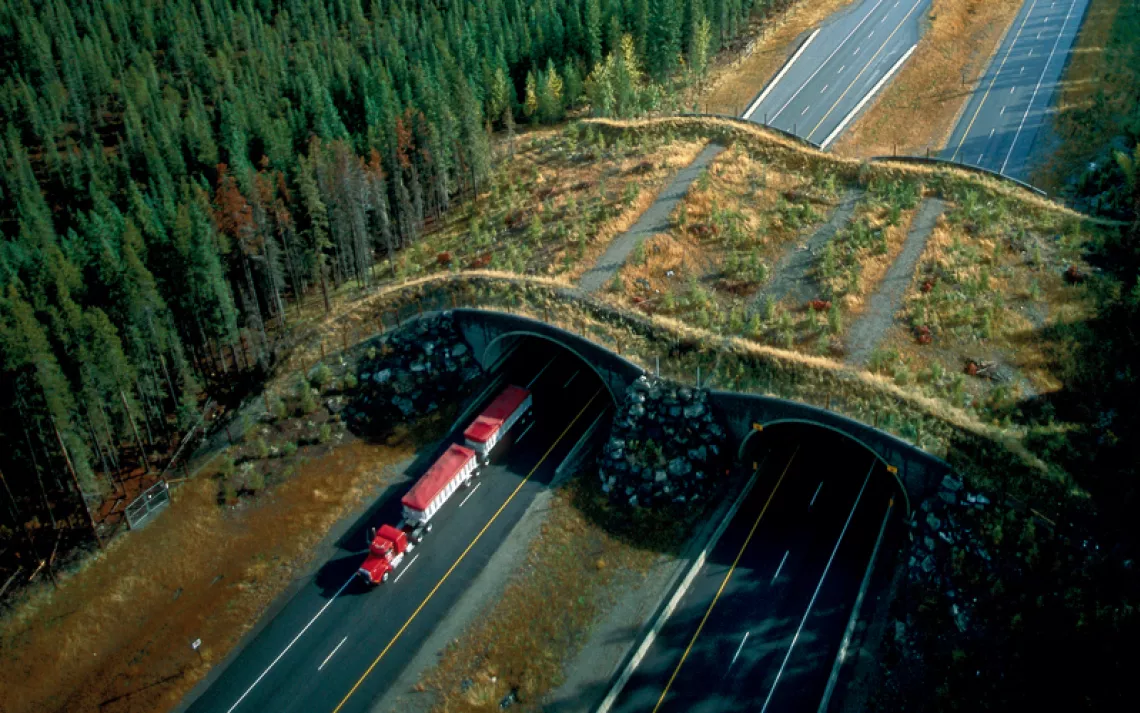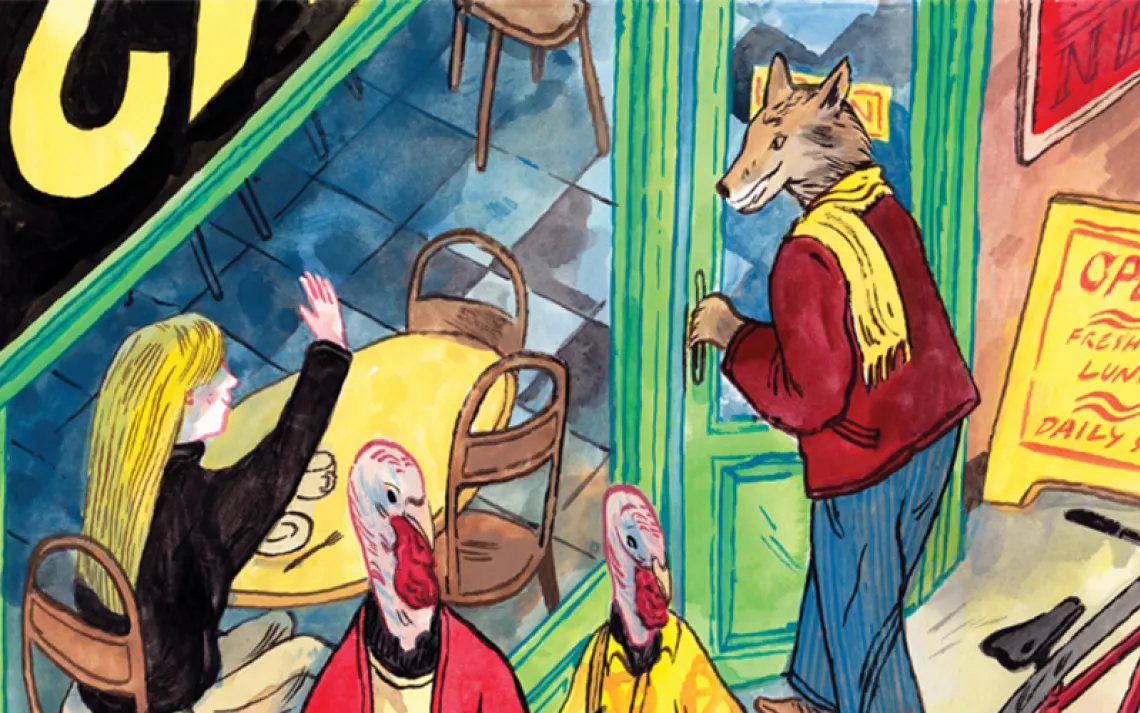A Visit to One of the Best Places to See Grizzly Bears in the Wild
A lottery system protects bears and humans in a sanctuary like no other

An Alaskan brown bear fishing for salmon at the McNeil River | Photo by Rick Sheremeta/REX Shutterstock/AP
Beth Rosenberg, an assistant manager at Alaska’s McNeil River Game Sanctuary, guides me and nine other visitors through sedge flats and beach pea, across gravel-bottomed, low-running creeks, and then up and over marsh carefully laid with geo-block to Mikfik Creek, where we find the object of our desire: grizzly bears, fishing for sockeye salmon at the lower falls. Rosenberg and the other guides carry packs with food and first aid supplies and journals for field notes. The guides also each have a rifle slung over their shoulders, but this is more precaution than necessity. The rifles have never been used. In its five decades as a designated wildlife sanctuary, McNeil maintains a perfect record: No humans or bears have ever been injured or killed here. The guides attribute this to the consistent and meticulous management of human behavior over such a long period of time. “We’ve taught the bears everything they know about people. They have no reason to be aggressive toward us.” Rosenberg says. “McNeil is unique. It’s a model for other places. It shows how things could be, what’s possible.”
When I remark that the bears seem comfortable around our group, Rosenberg corrects me and issues a warning against anthropomorphizing these animals and ascribing to them human-like motivations. Although Alaska Department of Fish and Game officials have given nicknames to the bears —there’s North Shore, Fisher, Aardvark, Split Decision, Quinoa, and Waterfalls—the bears’ easygoing demeanor is more a matter of animal instinct than any notion of “comfort.” At McNeil, the bears have never been hunted or fed. They don’t see humans as a food source or competition for food, territory, or a mate. They are still wild animals, yet the 600-pound, carnivorous brown bears at McNeil walk right by our group of gawking bipeds with little more than a sniff or a glance. It’s a perfect example of evolutionary instinct: Why would a bear waste time and energy attacking a human being who has proven to be innocuous when he could be fishing or mating instead?
The interactions between bears and humans at McNeill remain manageable, predictable, and safe in large part because the human presence is kept to a minimum. In 1973, the ADF&G instituted a lottery system to keep the number of visitors to just 10 people per day. When crowds overrun parks—as they do, for example, in Yellowstone—unsupervised and uneducated human behavior can bring out the worst in wildlife. Animals can become habituated to people, and when they get too close, things can go wrong, resulting in a human getting injured and a bear getting killed. McNeil has avoided such unfortunate incidents by scrupulously educating visitors in how to interact with bears without triggering their sometimes-aggressive instincts. In doing so, the sanctuary has created a bear-viewing experience unlike any other place on the planet.
McNeil River flows from the glaciers of the Aleutian Range toward the shores of the Alaska Peninsula’s Cook Inlet, about 250 air miles southwest of Anchorage—though flights from Homer to McNeil are more common. Upon arrival via floatplane from Homer, we show our identification and permits and are given a tour of the site before pitching our tents. Visitors, who are expected to bring their own gear, camp in a designated human-inhabited area of two acres inside the 120,000-acre refuge. Within that two-acre footprint, the camp offers a cook shack, pond-fed sauna, 14 primitive tent sites, two ADF&G cabins housing three guides, a food and garbage cache, and three outhouses with interiors decorated with Far Side and Tundra wildlife-themed cartoons. The camp has no fences or barriers of any kind. Bears have been discouraged over the years from entering the camp area and have learned to avoid this miniscule portion of their vast backyard. Still, I sleep with an air horn inside my tent. Guests are told to use two long blasts to alert staff to a bear inside the camp.
Each day the guides take us on a roughly five-mile hike through the sanctuary. We’re careful to do what we’re told, walking single file or in a tight-knit blob. We ease along bluffs with bald eagles soaring overhead. At a rest stop, a bear runs across the tall grass toward us and we stay still and photograph her as she approaches. Our lead guide and the sanctuary manager, Tom Griffin, offers some words to settle the group’s anxiety. “She’s a juvenile female. First year away from mom. She’s not charging. She’s curious and playful. We’d call her a cheeky bear.”
I kneel in the sand and photograph the buff-colored bear with a D-shaped scar on her nose as she wanders up to my camera. When she gets too close, Griffin clicks a couple of stones together and says “No bear” to her. Each time he does, she looks disappointed. Eventually, she wanders off to chase a flock of birds gathered along the shoreline.
There are, of course, other places in Alaska to view grizzly bears, the most well known being Katmai National Park and Preserve. But the experience here at McNeil is markedly different. While visitors at Katmai are kept at a distance from the bears, and most viewing occurs from elevated platforms, at McNeil we’re standing on the same ground as the animals, sometimes right next to them. At Katmai, visitors may feel like they are standing in line waiting for a table at a restaurant, as rangers with clipboards take names for your party while you wait to be called for your one-hour turn on the upper platform. Once there, you may or may not have a good view of the falls, depending on how tall you are and how many large lenses and tripods block your way. In this sense, Katmai has become more about navigating throngs of humans for a stressful, time-slotted glimpse of nature than communing with bears. While the human-bear interactions at McNeil are still carefully controlled, they are also more intimate, less scripted.
I eat my lunch overlooking the riffles while a male bear catches salmon below. When it’s safe, we pack up and cross the creek and stand atop the bluff on the other side. A sow with cubs lumbers down the river, and camera shutters click in rapid fire. The three yearling cubs have already learned to fish, but they’re still clumsy at it. The sow chases off the male bear and leads her cubs up the bank toward our group. She does not hesitate or growl at us. She’s more concerned about other bears than she is about people with cameras. The cubs stand on hind legs and totter over to us while their mother digs out grubs from a rotted log a few feet from where we stand. The cubs join her. They kick up dirt and wood and cover us with it. Moments later, mama bear lays down with her cubs to nurse them. I watch in silent reverence at a moment that’s rare and beautiful and fleeting.
If—or, more likely, when—these bears leave the protected area of McNeil, they are fair game for hunters. That means there are no guarantees that this bear or her cubs will return to McNeil in subsequent summers. But in this moment of familial bliss, the bears are safe in a haven. It’s a haven for people, too, a unique opportunity to connect with a four-legged cousin. Above all, it seems to me, McNeil is a model—time-tested proof of what is possible, what could be, in other places around the world.
Follow in the Writer’s Footsteps
Where: McNeil River State Game Sanctuary, Alaska Peninsula, 250 miles southwest of Anchorage and adjacent to Katmai National Park and Preserve
Permits: You have to be lucky to get a permit to be one of the 10 people per day selected to spend four days camping and bear viewing at McNeil. Permits run between June 7 and August 25, with a total of 185 individual permits awarded each year. Applications for 2018 must be submitted by March 1, 2018. Permit costs are slated to go up in 2018, but in 2017 the application fee was $25. If selected, Alaska residents pay $150 for the permit, and nonresidents pay $350. Standby permits are also issued. You can apply here.
Getting There: After being notified that you’ve been selected, start gathering your gear and book a flight from Homer or Anchorage into McNeil. Arrival and departure dates are based on your permit and the tides. The flight costs around $700, but it’s worth every penny for the hour and a half of flight-seeing and the end destination.
 The Magazine of The Sierra Club
The Magazine of The Sierra Club







